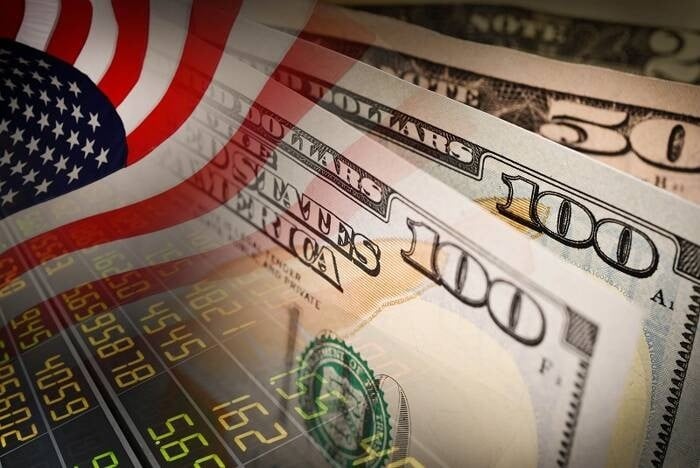 |
| Foreign exchange rates today, September 8: USD, EUR, CAD, Japanese Yen, British Pound, exchange rates... The US economy is getting stronger, the greenback is increasing. (Source: fxempire) |
The central exchange rate between Vietnamese Dong (VND) and US Dollar (USD) on the morning of September 8 was announced by the State Bank at 23,993 - 23,979 VND/USD, an increase of 14 VND compared to yesterday.
| STT | Currency code | Currency name | Bank rate commerce Buy | Bank rate commerce Sell | *State Bank exchange rate Apply for import and export from September 7-13 |
| 1 | EUR | Euro | 25,119.82 | 26,525.28 | 25,739.94 |
| 2 | JPY | Japanese Yen | 159.82 | 169.21 | 162.98 |
| 3 | GBP | British Pound | 29,287.30 | 30,534.85 | 30,137.49 |
| 4 | AUD | Australian Dollar | 14,964.95 | 15,602.41 | 15,325.45 |
| 5 | CAD | Canadian Dollar | 17,148.65 | 17,879.12 | 17,590.00 |
| 6 | RUB | Russian Ruble | 234.92 | 260.08 | 246.66 |
| 7 | KRW | Korean Won | 15.61 | 19.02 | 18.02 |
| 8 | INR | Indian Rupee | 288.66 | 300.23 | 288.80 |
| 9 | HKD | Hong Kong Dollar (China) | 2,993.27 | 3,120.77 | 3,059.10 |
| 10 | CNY | Chinese Yuan China | 3,216.64 | 3,354.16 | 3,282.84 |
(Source: State Bank, Vietcombank )
Exchange rate developments in the world market
In the US market, the US Dollar Index (DXY), which measures the greenback's fluctuations against six major currencies (EUR, JPY, GBP, CAD, SEK, CHF), increased by 0.19% to 105.05.
The greenback exchange rate in the world today continues to increase, while European currencies continue to decrease.
Specifically, the greenback continued to rise in the last trading session, while the Japanese Yen hit a 10-month low, and the Euro and the British pound also hit a three-month low, amid a strong US economy, despite the tightening of monetary policy by the US Federal Reserve (Fed).
A slew of new data points to a resilient U.S. economy overall. “It’s all about the U.S. economic outperformance relative to other countries,” said Brad Bechtel, global head of foreign exchange at Jefferies in New York. “That continues to be a big catalyst for the greenback.”
New economic data showed that initial state unemployment claims unexpectedly fell to 216,000 last week. Economists had forecast new claims rising to 234,000 last week.
Another report showed that productivity growth in the second quarter was flat but steady. Nonfarm productivity, a measure of hourly output per worker, rose at a 3.5% annual rate in the April-June period — the highest since the third quarter of 2020 — after falling 1.2% in the first three months of the year. Second-quarter productivity growth was initially estimated at 3.7%.
According to the CME FedWatch tool, the market is currently pricing in a more than 40% chance that the Fed will deliver another rate hike in November, and will leave rates unchanged at the end of this month.
In another development, on September 6, the Euro fell 0.3%, currently at 1.0696 USD, after falling to its lowest level since June.
European Central Bank (ECB) policymakers warned investors that there was still no clarity on a decision on interest rate hikes next week, but that a rate hike was one of the options on the table.
In Japan, traders continued to watch for government intervention as the yen struggled to maintain its gains against the dollar. The greenback hit a fresh high of 147.875 yen earlier, its highest since November, and closed down 0.4% at 147.20.
Meanwhile, the British pound hit a three-month low, down 0.3% to $1.2470.
Bank of England (BoE) Governor Andrew Bailey said on September 6 that the central bank is about to end its interest rate hike cycle, although borrowing costs may still rise further due to persistent inflationary pressures.
The Australian dollar fell 0.1% to $0.6379, while the New Zealand dollar gained 0.2% to $0.5870, both weakening near 10-month lows.
Source






























![[Photo] Nghe An: Provincial Road 543D seriously eroded due to floods](https://vphoto.vietnam.vn/thumb/1200x675/vietnam/resource/IMAGE/2025/8/5/5759d3837c26428799f6d929fa274493)


































































Comment (0)